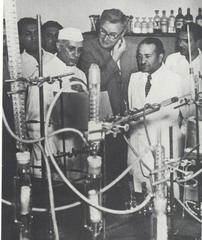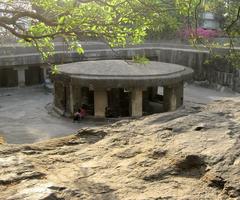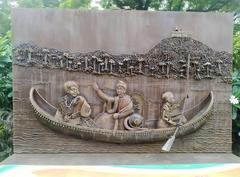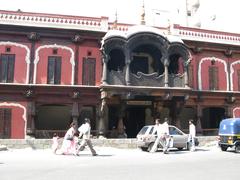Visiting Parvati in Pune: Hours, Tickets, and Historical Insights
Date: 23/07/2024
Introduction
Parvati Hill, located in Pune, India, is a site of immense historical, cultural, and natural significance. As one of the city’s most prominent landmarks, it offers visitors a unique blend of ancient temples, panoramic views, and a rich legacy that dates back centuries. This guide aims to provide a comprehensive overview of Parvati Hill, covering its historical origins, cultural importance, and practical visitor information to ensure a memorable experience. Known for its serene environment and architectural marvels, Parvati Hill is an essential destination for history enthusiasts, spiritual seekers, and travelers exploring Pune’s historical sites. The hill’s history extends back to the Satavahana dynasty, with significant developments during the Maratha era. Today, it continues to attract thousands of visitors, thanks to efforts by the Pune Municipal Corporation and other organizations to preserve and promote its heritage. For more information on Parvati Hill’s history and visiting tips, you can visit the Pune Municipal Corporation website.
Table of Contents
- Introduction
- History of Parvati Hill
- Visitor Information
- Cultural Significance
- Architectural Features
- Preservation Efforts
- Nearby Attractions
- FAQ Section
- Conclusion
Exploring Parvati Hill - History, Visiting Hours, Tickets, and More
History of Parvati Hill
Ancient Origins
Parvati Hill, located in Pune, India, is a site of immense historical significance. The hill is home to the Parvati Temple, which dates back to the 17th century. However, the history of the area extends much further back. Archaeological evidence suggests that the region around Parvati Hill has been inhabited since ancient times, with artifacts dating back to the Satavahana dynasty (circa 1st century BCE to 2nd century CE) being discovered in the vicinity. The Satavahanas were known for their contributions to Indian culture, including the promotion of Buddhism and the construction of stupas and viharas.
The Maratha Era
The most significant period in the history of Parvati Hill is undoubtedly the Maratha era. The hill and its temples were constructed under the patronage of the Peshwas, the prime ministers of the Maratha Empire. The Parvati Temple complex was built by Balaji Baji Rao, also known as Nana Saheb Peshwa, in the 1740s. The Peshwas were instrumental in expanding the Maratha Empire and played a crucial role in Indian history during the 18th century. The Parvati Temple complex includes several temples dedicated to various deities, including Parvati, Vishnu, and Kartikeya. The main temple, dedicated to Parvati and Shiva, is an excellent example of Maratha architecture, featuring intricate carvings and a distinctive style that reflects the artistic sensibilities of the period.
British Colonial Period
During the British colonial period, Parvati Hill continued to be an important cultural and religious site. The British recognized the historical significance of the area and took measures to preserve the temples and other structures on the hill. The hill also served as a vantage point for the British, offering a panoramic view of Pune and its surroundings. In the 19th century, the British constructed a small bungalow on Parvati Hill, which was used as a rest house for British officers. This bungalow, known as the Parvati Hill Bungalow, still stands today and is a testament to the colonial history of the area.
Post-Independence Era
After India gained independence in 1947, Parvati Hill continued to be a popular destination for both locals and tourists. The hill and its temples have been maintained by various government and private organizations, ensuring that the historical and cultural heritage of the area is preserved for future generations. In recent years, efforts have been made to promote Parvati Hill as a tourist destination. The Pune Municipal Corporation has undertaken several initiatives to improve the infrastructure around the hill, including the construction of pathways, lighting, and other amenities for visitors. These efforts have helped to increase the visibility of Parvati Hill and attract more tourists to the area.
Visitor Information
Parvati Hill Visiting Hours
Parvati Hill is open to visitors every day from 5:00 AM to 8:00 PM. Early morning visits are recommended to enjoy the serene environment and panoramic views without the crowd.
Parvati Hill Tickets
There is no entry fee to visit Parvati Hill and its temples. However, donations are appreciated to help with the maintenance and preservation of the site.
How to Get There
Parvati Hill is located in the Parvati Paytha area of Pune. It is easily accessible by public transport, including buses and auto-rickshaws. For those driving, there is parking available at the base of the hill.
Travel Tips
- Wear comfortable shoes, as you will need to climb around 103 steps to reach the top of the hill.
- Carry water and snacks, especially if you plan to spend a few hours exploring the area.
- Respect the cultural and religious significance of the temples by dressing modestly and following local customs.
Cultural Significance
Parvati Hill holds a special place in the cultural and religious landscape of Pune. The temples on the hill are an important pilgrimage site for Hindus, who visit the hill to seek the blessings of the deities. The hill is also a popular spot for locals, who come to enjoy the serene environment and panoramic views of the city. The Parvati Temple complex is also a hub of cultural activities. Various festivals and events are held at the temples throughout the year, attracting devotees and tourists alike. One of the most significant festivals celebrated at Parvati Hill is the annual Ganesh Chaturthi festival, which sees thousands of devotees flocking to the hill to participate in the festivities.
Architectural Features
The architecture of the Parvati Temple complex is a reflection of the Maratha style, characterized by its simplicity and elegance. The temples are constructed using locally available materials, including basalt and limestone. The main temple, dedicated to Parvati and Shiva, features a shikhara (spire) that rises above the sanctum sanctorum, a common feature in Hindu temple architecture. The temples are adorned with intricate carvings and sculptures, depicting various deities and mythological scenes. The walls of the temples are decorated with frescoes and murals, showcasing the artistic talents of the craftsmen of the period. The temple complex also includes several smaller shrines dedicated to other deities, each with its unique architectural features.
Preservation Efforts
Preserving the historical and cultural heritage of Parvati Hill has been a priority for various organizations and individuals. The Archaeological Survey of India (ASI) has undertaken several initiatives to conserve the temples and other structures on the hill. These efforts include regular maintenance, restoration of damaged structures, and protection of the site from encroachments and other threats. In addition to the efforts of the ASI, local organizations and community groups have also played a crucial role in preserving the heritage of Parvati Hill. These groups organize clean-up drives, awareness campaigns, and other activities to promote the conservation of the site. Their efforts have helped to ensure that Parvati Hill remains a vibrant and well-preserved historical site.
Nearby Attractions
While visiting Parvati Hill, consider exploring other nearby attractions in Pune:
- Shaniwar Wada - A historical fortification in the city of Pune and one of the most famous landmarks of the Maratha Empire.
- Aga Khan Palace - A majestic building with a rich history, now a museum dedicated to Mahatma Gandhi.
- Sinhagad Fort - A hill fortress located near Pune with a significant historical background and stunning views.
FAQ Section
Q: What are the visiting hours for Parvati Hill? A: Parvati Hill is open every day from 5:00 AM to 8:00 PM.
Q: Is there an entry fee for Parvati Hill? A: No, there is no entry fee to visit Parvati Hill.
Q: How many steps are there to climb Parvati Hill? A: There are approximately 103 steps to climb to reach the top of Parvati Hill.
Q: Are there any festivals celebrated at Parvati Hill? A: Yes, the annual Ganesh Chaturthi festival is one of the most significant events celebrated at Parvati Hill.
Conclusion
Parvati Hill offers a unique blend of history, culture, and natural beauty, making it a must-visit destination in Pune. Whether you are interested in exploring ancient temples, enjoying panoramic views, or learning about the rich history of the area, Parvati Hill provides an unforgettable experience. Plan your visit today and immerse yourself in the enchanting allure of this historical gem. For more information on the history and significance of Parvati Hill, you can visit the Pune Municipal Corporation website.




